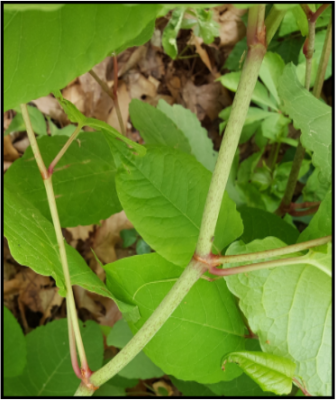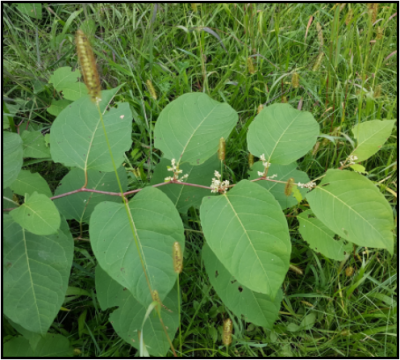Fallopia japonica, syn. Polygonum cuspidatum
By Victoria Wallace, Alyssa Siegel-Miles, and Klaudia Sowizral, UConn Extension
Identifying Features
- OVERVIEW: Perennial, herbaceous. Shrubby in appearance. Height 6-15 ft, with a deep taproot. Allelopathic (releases chemicals that can inhibit the growth of neighboring plant species).
- LEAVES: Simple, alternate; 4-6 in long, 3-5 in wide. Broadly ovate (broad and rounded or squared at the base); come abruptly to a point. Emerges in early spring, initially appearing visually similar to rhubarb or bamboo, then unfurls with distinctly triangular, bright red-purple leaves that turn green over time.
- STEMS: Smooth, noticeably jointed and with reddish-purple mottling at nodes. Ocrea (thin sheath) present at nodes, where the stem is swollen. Hollow between nodes. Covered in a fine whitish coating that easily rubs off.
- FLOWERS: Small white/cream colored flowers occur in lacey, 3-4 in long clusters at the upper leaf axils along the length of the stem in late August-Sept.
- SEED/FRUIT: Dark brown, glossy, tiny seeds are enclosed in 8-9 mm long, three-winged achemes (papery fruits). Can be dispersed by wind, water, transported soil, birds, or insects. Dioecious.
- ROOTS: Deep taproot and extensive rhizomes (underground stems). Up to two-thirds of the plant's biomass exists underground (fs.fed.us).
- REPRODUCTION/SPREAD: Primarily vegetative by rhizomes, and, to a lesser extent, by seed. Extensive network of rhizomes quickly crowds out surrounding vegetation. Easily regenerates/forms clonal shoots from small pieces of rhizome or root tissue.

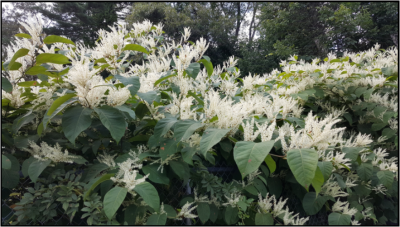
Habitat
Japanese knotweed thrives in disturbed areas, along roadsides, and on stream or river banks, forming dense thickets that pose a significant ecological threat to riparian areas. Its ability to rapidly colonize an area threatens native vegetation and can greatly alter natural ecosystems. It can grow well in full sun, deep shade, soils of high salinity, and extreme drought. It can also survive severe floods. Its extensive root system has been known to penetrate asphalt and cracks in concrete.
Control
Prevention is key: early detection and rapid response are the most effective means of Japanese knotweed management.
MECHANICAL CONTROL:
- Cut plants with pruners or loppers three times per year, in May or early June, mid-July, and late August before flowers appear. The third cut should be completed before fall (by August 31 is recommended) to prevent the movement of the plants’ energy from its leaves to its rhizomes. Each stem should be cut below the lowest node. Repeat this process for a minimum of three years.
- Place all removed plant material in heavy duty contractor bags and dispose of in regular trash. Do not place any cut plant material in a compost pile or leave on site. Rhizome fragments left on the ground can easily resprout.
- Follow-up maintenance for multiple years is critical to eradication success and to eliminate sprouting from all rhizomes, which may produce new shoots for three years. Refer to Nip the Knotweed for more details.
- Digging and hand-pulling of established plants are NOT recommended as new shoots can easily form on root and rhizome fragments. (Hand-pulling is recommended for very young plants only.)
- Stem cutting efforts can be combined with shading (black or clear plastic) or a chemical application.
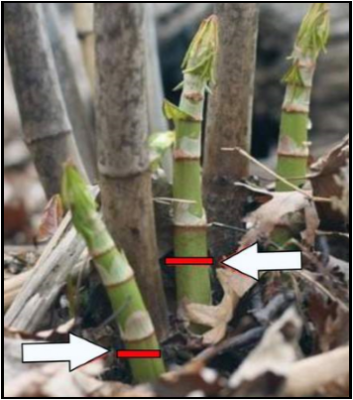
CHEMICAL CONTROL: Follow label instructions for any chemical application.
- Herbicides (e.g., glyphosate with a surfactant or triclopyr) can be applied on leaf surfaces with sprayers, painted on cut stems, or administered via stem injection.
- Applications are recommended in late summer before flowering or just after flowering up until the first killing frost (September-November). Do not spray when plants are flowering; many pollinators feed on the flowers.
- Recommended protocol: Cut or mow the plant to 2-3 in during mid-late spring (May-June) to prepare for a planned foliar treatment in late summer or fall. Cutting the plant in spring reduces plant height at the time of spraying, enabling better control of the spray, decreases the amount of product needed, and delays flowering so that plants can be sprayed in August without risk of harm to pollinators.
- Follow-up treatments, the following year, are essential to managing populations of Japanese knotweed, and should be timed after July 1st, similar to the initial treatment. Following year two, chemical treatments may be repeated every two years.
- Refer to New Hampshire Department of Agriculture or Michigan Extension for more details.
After cutting or chemical control (year two), replant with native species to minimize knotweed re-establishment.
Distribution
Japanese knotweed is found throughout much of the U.S., especially in the Northwest, the Northeast, and the Northern Midwest.
Other Facts and Background
Japanese Knotweed is native to Eastern Asia, including China, Japan and Korea. It was introduced to the U.S. as an ornamental in the late 1800s and was initially used for erosion control. Its population spread rapidly and was noted as a problematic species by 1930. The plant is reported to have medicinal applications.
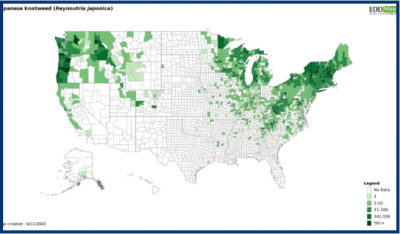
SOURCES:
- Connecticut Invasive Plant Working Group. (n.d.). Japanese Honeysuckle (Lonicera japonica). https://cipwg.uconn.edu/japanese-honeysuckle/
- Cygan, D. (2018). Preventing the Spread of Japanese knotweed, Reynoutria japonica(AKA: Fallopia japonica, Polygonum cuspidatum): Best Management Practices. New Hampshire Department of Agriculture, Markets & Food. https://www.agriculture.nh.gov/publications-forms/documents/japanese-knotweed-bmps.pdf
- Maine Natural Areas Program. (n.d.) Maine Invasive Plants Bulletin #2511: Japanese Knotweed/Mexican Bamboo. University of Maine Cooperative Extension. https://extension.umaine.edu/gardening/2024/05/24/how-can-i-control-japanese-knotweed-on-my-new-property
- Michigan Department of Natural Resources. (2012, February). Invasive Species - Best Control Practices: Japanese Knotweed. https://mnfi.anr.msu.edu/invasive-species/JapaneseKnotweedBCP.pdf
- New York Invasive Species (IS) Information. (2013, November 9). New York Invasive Species Clearinghouse Species Profile: Polygonum Cuspidatum Sieb. & Zucc., Japanese Knotweed. Cornell Cooperative Extension & SeaGrant New York. https://nyis.info/species/japanese-knotweed/#:~:text=Japanese%20knotweed%20spreads%20rapidly%2C%20forming,have%20very%20little%20other%20growth.
- Parkinson, H., Pokorny, M., Mangold, J., & Scianna, J. (2017, May). Ecology And Management Of Invasive Knotweeds (Polygonum Spp.). Invasive Species Technical Note No. MT-34. United States Department of Agriculture Natural Resources Conservation Service. https://www.nrcs.usda.gov/plantmaterials/mtpmctn13168.pdf
- Templeton, S. Gover, A., Jackson, D., & Wurzbacher, S. (Updated 2020, February 24). Japanese Knotweed. PennState Extension. https://extension.psu.edu/japanese-knotweed
- Varricchio, E. & Connecticut Invasive Plant Working Group. (n.d.). Connecticut’s Invasive Plant Management Calendar: The Top 10 Invasive Plants [PowerPoint slides]. Connecticut Invasive Plant Working Group. https://cipwg.uconn.edu/wp-content/uploads/sites/244/2018/10/Invasive-Plant-Management-Calendar.pdf
Questions? Contact:
Vickie Wallace
UConn Extension
Extension Educator
Sustainable Turf and Landscape
Phone: (860) 885-2826
Email: victoria.wallace@uconn.edu
Web: ipm.uconn.edu/school
UConn Extension is committed to providing equal access and full participation for individuals with disabilities within all our programs and activities. Visit s.uconn.edu/accessibility for more resources. UConn is an equal opportunity program provider and employer.
Funds to support the creation of this document were provided by the Crop Protection and Pest Management Extension Implementation Program [grant no. 2017-70006-27201/project accession no. 1013777] from the USDA National Institute of Food and Agriculture.
©UConn Extension. All rights reserved.
Updated May 2021
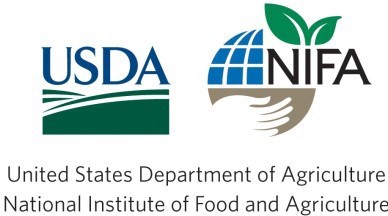 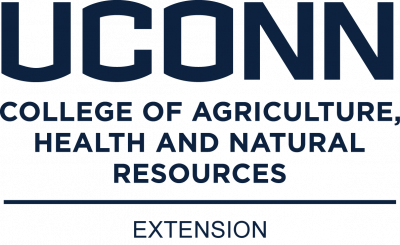 |
